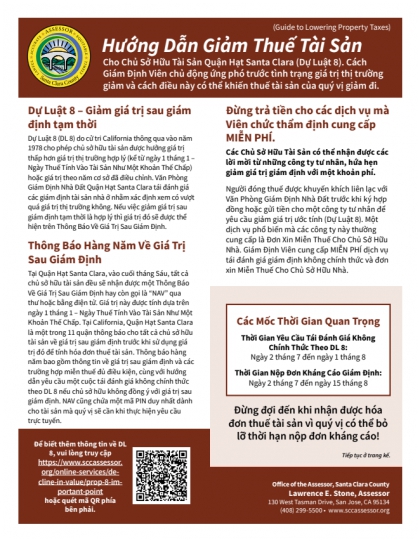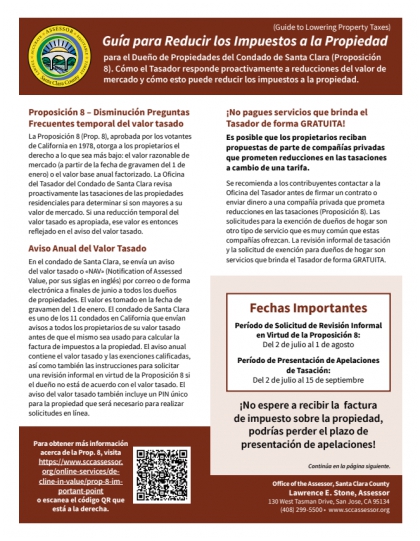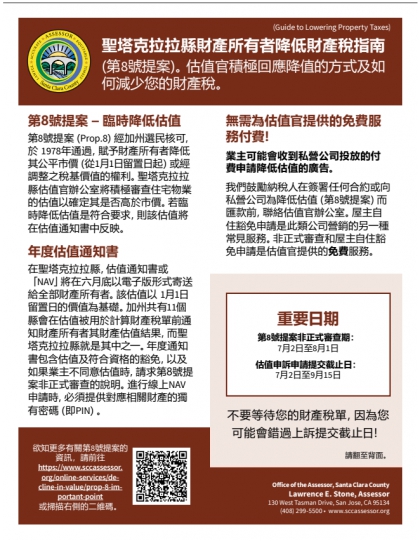
Commercial Owners Seeking Temporary Property Tax Reduction for 2025-2026
The Assessor’s Office has the authority to temporarily reduce property tax assessments in accordance with Proposition 8 based if the market value—as of January 1—falls below factored base year value (Prop 13 value). Proposition 8 only allows for temporary reductions on land and buildings. However, tenants, such as hair and nail salons or restaurants, may receive reductions through a property owner in accordance with their lease.
Data will continue to be accepted up to August 1, 2025. Below are examples of the requested industry-specific data. This information will be used by the Assessor’s Office to evaluate potential opportunities to reduce 2025-2026 property taxes for commercial properties.
To apply for a reduction, applicants are encouraged to have the above data compiled electronically prior to completing the on-line application below.
Information needed by Assessor's office from all Owners:
- Best estimate of prospective income and expense statements for the 2025 calendar year.
- Actual income and expense statements for the 2023 and 2024 calendar years.
- Description and actual cost of any new construction completed or in progress, during the 2024 calendar year.
- Copy of any appraisal performed on the property for any purpose within the last two years.
- Any other information relevant for the proper determination of value.
Hotel/Motel:
- Opinion of value as of January 1, 2025, and the information used to form your opinion.
- Number of units, average annual room rate (ADR). RevPar, and occupancy rate for three calendar years prior to the date in question along with three calendar years of income and expense statements.
- If Change of ownership in 2025, provide purchase or sales agreement & closing statements including all addendums. Franchise Agreement, Management Agreement, Franchise Inspection Report, and Product Improvement Plan.
- Description and actual cost of any new construction completed or in progress, during the 2024 calendar year.
- Copy of any appraisal performed on the property for any purpose within the last two years.
- Any other information relevant for the proper determination of value.
Frequently Asked Questions About Stanford Leased Housing Property Taxes
1. What is the process that the Assessor uses to establish the base year value of on-campus housing subject to a lease?
In accordance with Proposition 13, the assessed value for a home is the prior year’s assessed value adjusted for inflation up to 2 percent. However, if there has been a change in ownership or completed new construction, the new assessed value will be the market value of the property as of the date of the ownership change or new construction. When a home is acquired, subject to a lease with Stanford, the leasehold interest is the equivalent of ownership of the property. This is legally known as “fee simple interest”. The law requires the Assessor to treat the leaseholder like all other homeowners. The law states that both the leaseholder and all other property owners effectively have the same property rights. When a transfer occurs, triggering a change in the fee simple ownership interest, it requires the Assessor to establish a base year value for property tax purposes per Revenue and Taxation Code section 110.1 and Property Tax Rule 462.100. The base year value, established because of the transfer of ownership, is set at the Fair Market Value of the property as it is defined in Section 110 of the Revenue and Taxation Code: “as the amount of cash or its equivalent that property would bring if exposed for sale in the open market …” Section 110(b) states that “For purposes of determining the “full cash value” or “fair market value” of real property, other than possessory interests, being appraised upon a purchase, “full cash value” or “fair market value” is the purchase price paid in the transaction, unless it is established by a preponderance of the evidence that the real property would not have transferred for that purchase price in an open market transaction.” If the Assessor can demonstrate that the property would not have sold for a nominal sales price because it was not an open-market transaction, the property is assessed at its fair market value as determined by the value of homes in the greater Palo Alto community. Consequently, the Assessor must consider the greater Palo Alto market for comparable sales that have been exposed to the open market to complete an appraisal of the fair market value of Stanford housing units.
2. Is it possible that the purchase price between Eligible Persons could ever be indicative of fair market value and establish the base value for property tax purposes?
Yes, it is possible, but coincidental that the Assessor could enroll the purchase price for a long-term leasehold interest as establishing the base year value. See below, the example of a chart showing actual data from the Assessor. However, the acceptance of that purchase price would only result after the Assessor had completed an appraisal of the property, based upon comparable sales that had been exposed to the open market and led to a conclusion of market value. This coincidence is most likely to occur for properties at the lower end of the market, where eligible persons have similar purchasing power as participants in the greater market.
3. Can new faculty purchasers challenge the Assessor’s assessments?
Faculty has the right to appeal its newly issued assessments by filing an Assessment Appeal Application with the clerk of the local Assessment Appeals Board (AAB). Assessment Appeal Applications must be filed within 60 days of the mailing date of any notice of the newly issued assessed value (i.e., a supplemental or escape assessment). The Assessor's annual assessments can also be appealed by filing an Assessment Appeal Application between July 2 through September 15 of each year. A separate application must be filed for each year the assessments are being disputed. Applicants must strictly adhere to these filing deadlines and are encouraged to retain proof of timely filing. Assessment Appeal Applications for residences can be heard by either a three-member local Assessment Appeals Board, or by a hearing officer designated by the Assessment Appeals Board. Decisions of the Assessment Appeals Board, or hearing officer, are appealable to the California courts. The courts are required to give great weight to the Assessment Appeals Board's determinations as to value, and may only overturn them if the court concludes that the Assessment Appeals Board had no substantial evidence to support its value determinations. For additional information about Assessment Appeal Applications, see the California State Board of Equalization's Publication 30 (Residential Property Assessment Appeals) available at https://www.boe.ca.gov/proptaxes/pdf/pub30.pdf. Stanford assessments have been contested multiple times, and twice have had a full hearing. In one instance, the AAB upheld the Assessor’s determination of the fair market value of the property. In another case, the AAB raised the value above the Assessor’s recommendation.
4. How can Faculty Staff Housing assist Eligible Persons who are considering purchasing a long-term leasehold interest anticipate their property tax obligations?
The University and Faculty Staff Housing remain committed to supporting its faculty and continue to strive to find innovative ways to provide affordable housing in this challenging climate. Faculty Staff Housing has updated its website, disclosures, purchase contracts and related documents to educate faculty regarding the obligation, per the California Revenue and Taxation Code, of the Assessor to assess property at its fair market value, regardless of the private restrictions inherent in the Stanford Faculty Housing Program. Faculty Staff Housing is working with the Affordability Task Force. This Task Force has been tasked with developing and presenting recommendations aimed, in part, in assisting Eligible Persons to understand and anticipate their property tax obligations and longstanding assessment practices. These recommendations will be provided to the Steering Committee at the end of summer 2019, and presented to the Board of Trustees in December 2019. As a result of Faculty Staff Housing's collaboration with the Affordability Task Force, faculty who purchased their homes before January 1, 2019 and receive above purchase price reassessments, are eligible to receive up to $10,000 a year for two years to cover the property taxes owed on the above purchase price assessments. As part of this program, faculty receiving above purchase price assessments have been offered one-on-one consultations with a licensed real estate appraiser or Faculty Staff Housing personnel to help explain the property tax assessment process. Faculty Staff Housing has connected faculty with property tax consultants capable of pursuing an appeal to challenge the Assessor's new assessed value determination on the property. At the Assessor's suggestion, Faculty Staff Housing is launching an appraisal program whereby any new listings of homes for sale in the subdivision would receive a “fee simple” appraisal of the property. The appraisal will be provided to the seller and potential buyers to assist the parties in understanding the Assessor's likely assessed value for the property following the transaction. The appraisal will also be provided to the Assessor's Office. This appraisal report will be provided at Stanford's cost, and will be folded into the process of listing properties for sale in the subdivision.
5. If faculty only own leasehold interests, how can the Assessor base the faculty's property tax assessments on the value of the entire “fee simple interest” in the property?
The appraiser must determine the fair market value of the unrestricted fee simple estate, unencumbered by leases, based on the highest and best use of the property (AH 501). Private parties cannot reduce the taxable value of their property by imposing private restrictions. Only enforceable government restrictions are recognized as limiting the full fee simple interest, per R & T 402.1.
6. How can I anticipate the property tax obligation associated with my long-term leasehold interest in Stanford property?
The amount of property taxes faculty would be required to pay depends on the Assessor’s determination of the market value of the property. In any case, the property tax rate varies by tax year, but is generally around 1.15%. So, for example, if the Assessor’s market value conclusion is determined to be $1.5M, then the annual property tax would be $17,250. For further information regarding property tax obligations, please review the Assessor’s website at https://www.sccassessor.org/. And to learn about supplemental assessments, please see the following informational video https://youtube/-v6q-4KGqdM&feature=player_embedded.
7. Tell me more about Faculty Staff Housing’s new program to commission fee simple appraisals on properties listed for sale. What is the purpose of this new requirement and how will it work?
Market value appraisals will assist Stanford faculty and staff understand market realities. The purchase price is not necessarily reflective of market value and that they may end up with an increased assessment and tax bill. The Assessor has advised that the best way for Eligible Persons to anticipate their base year determination is to obtain a fee simple appraisal at the time the transaction closes. Faculty Staff Housing has carefully considered the Assessor's recommendation and has agreed to provide the requested appraisals to the buyer and the Assessor. These appraisals will not be binding on the Assessor. Under the program, sellers will notify Faculty Staff Housing of their desire to list their residences for sale. The seller will be required to select a licensed real estate appraiser from Stanford's preapproved list. Faculty Staff Housing will then commission the appraisal report and will cover the cost of the report. Subsequent appraisal reports will be the responsibility of the requesting party. The seller will be given an opportunity to review the appraisal report for any material errors before it is finalized. Faculty Staff Housing will provide the seller with a copy of the final appraisal report, which is expected to take approximately 30 days to complete from the date it is commissioned





